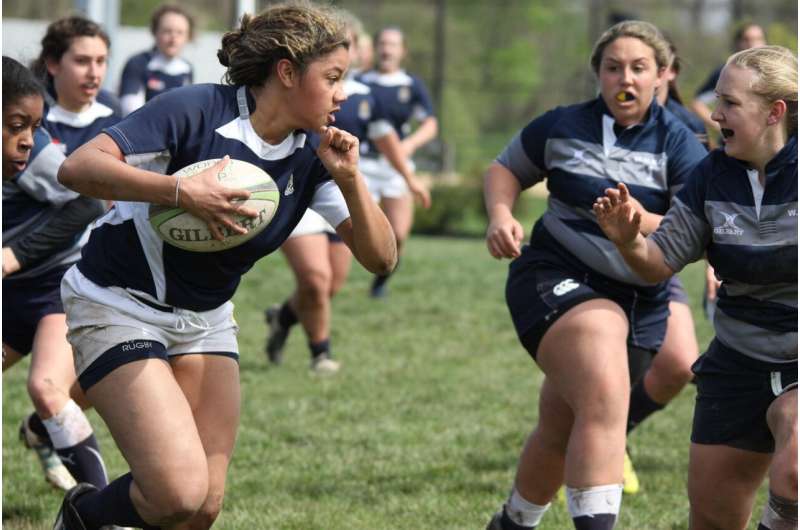This article has been reviewed according to Science X's editorial process and policies. Editors have highlighted the following attributes while ensuring the content's credibility:
fact-checked
trusted source
written by researcher(s)
proofread
Concussion risks for women footballers are greater than for men—why, and what can be done?

Since the inception of the Australian Football League Women's (AFLW) competition in 2017, women's football participation has increased rapidly, from about 380,000 in 2016 to around 600,000 in 2022.
Women now represent approximately one-third of all players nationally.
During this time, the AFLW has evolved dramatically.
In 2017, it started with eight teams playing a short eight-round competition. Next season, which begins on Friday night, 18 teams will play across a 15-round campaign.
By 2026, the competition will feature a full 17-round season, with female AFLW players becoming full-time athletes like the men.
The impact of injuries
Team success and career longevity rely heavily on one critical factor—staying healthy.
Teams with lots of injuries don't win many games, and injured players often have shorter careers.
This is why injury prevention is one of the most heavily researched topics around the globe.
The first step in any good injury prevention plan is injury surveillance.
Injury surveillance is the process of observing and tracking injuries to identify which are most common and result in the most missed matches.
By identifying the areas of greatest need, targeted injury prevention strategies can be created.
There is a large body of research examining the most common injuries in male Australian football at all levels (including community, sub-elite and elite).
This research is often used to guide injury prevention strategies for women's football.
However, this has an issue—we don't know if women have the same injury patterns as men.
This is important when we consider there are key differences between how men's and women's Australian football is played.
At some levels (such as elite and sub-elite), women's football is currently played with 16 players on the field, rather than 18.
It has a shorter game duration and fewer player rotations than the men's competition, which can affect the speed of the game and the fatigue players experience.
Finally, stoppages occur 30% more often in women's football, and women's teams have more than twice as many contested possessions and tackles per minute of match-play than men, highlighting it has more frequent player-to-player contact.
Key differences between men and women
Researchers from the University of South Australia recently conducted the largest league-wide study of the injury patterns of sub-elite women's football to date, tracking the injures experienced by seven clubs competing in the South Australian National Football League Women's competition during the 2023 season.
Ankle sprains, concussions and anterior cruciate ligament (ACL) injuries were the most common and burdensome. Conversely, there were very few muscle strains.
Most injuries occurred during matches (rather than at training), and more than two-thirds occurred in a contact situation (such as during a tackle or a marking contest).
Importantly, these injury patterns were notably different from those often seen in males.
First, hamstring muscle strains were one of the least common injuries, despite being one of the most common in men.
Second, ACL injuries occurred about twice as often in women than men.
Finally, and arguably most notably, concussion rates were about three-times higher than men—something that has been seen in prior seasons at the elite AFLW level.
Similar observations have been made in other contact sports such as rugby, where women not only experience higher rates of concussion, but also get concussed via different mechanisms to men.
Not only does this suggest women require different injury prevention strategies than men, but that concussion injuries should be a key prevention focus for all competition levels.
What could be done to fix the issue?
There are some possible concussion prevention strategies that could be considered for women footballers.
Tackles with an upright body position have been shown to increase the likelihood of the tackler's head contacting their opponent's shoulder, which increases concussion risk.
So specific tackle skill training to ensure athletes keep a low body position and contact the opposition's mid-section could be an option to help reduce the rate of tackle-related concussion.
Recent research has indicated neck strength might protect against concussions and that injury prevention programs that include neck exercises can reduce the number of head and neck injuries.
As such, exercises to improve neck strength could be a great introduction to pre-season training, in conjunction with normal upper and lower body strength training.
Similarly, a study of athletes from a range of sports (including soccer and volleyball) suggested improving core muscle strength and stability may reduce the risk of concussion, which could be trained easily throughout the entire season.
Finally, rule changes could reduce the opportunity for contact concussions to occur. Some common suggestions have included banning "the bump" to reduce shoulder to head contact, and limiting the number of players allowed on one side of the field during a kick in after a point is scored to reduce congestion.
This article is republished from The Conversation under a Creative Commons license. Read the original article.![]()





















